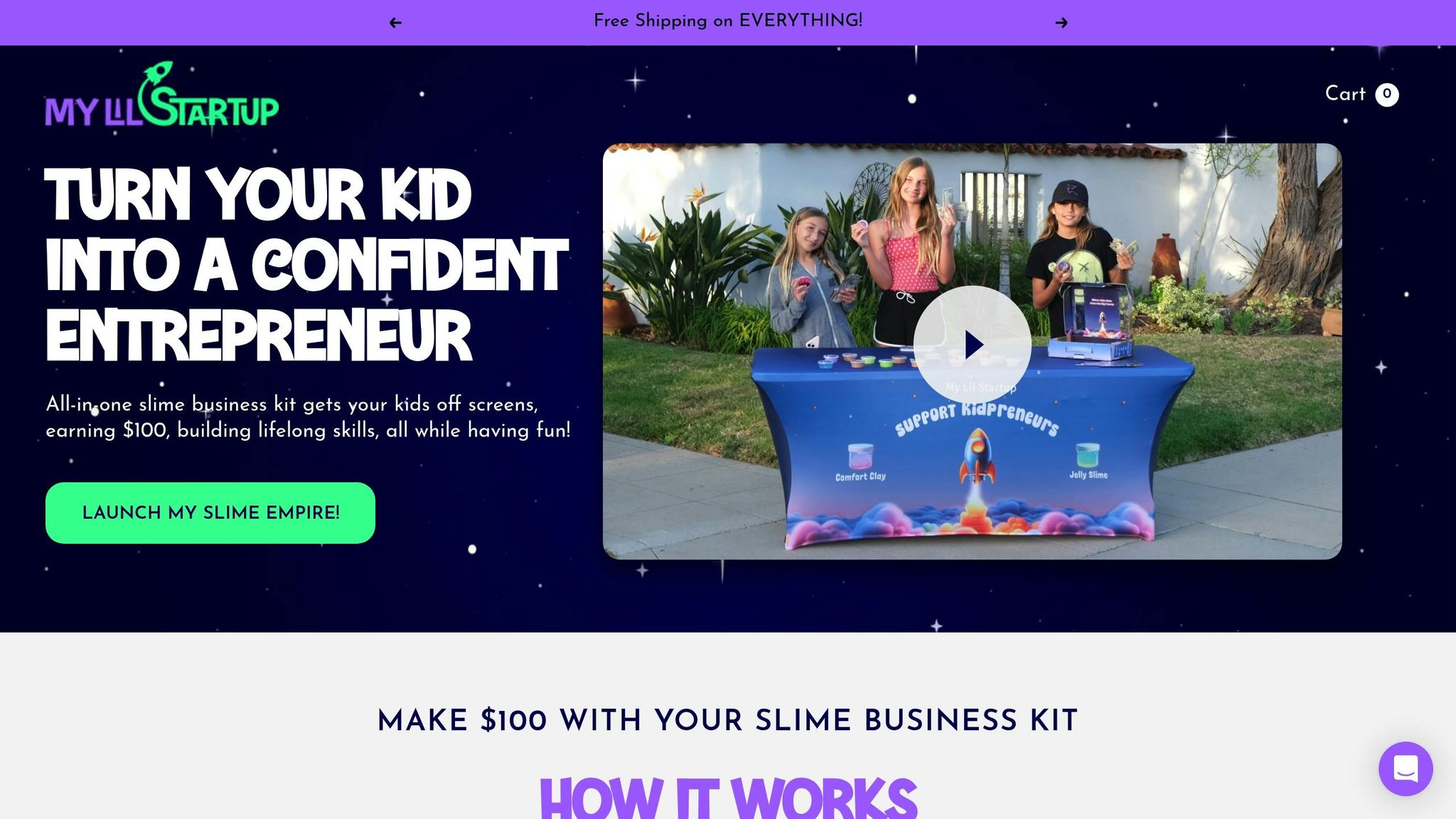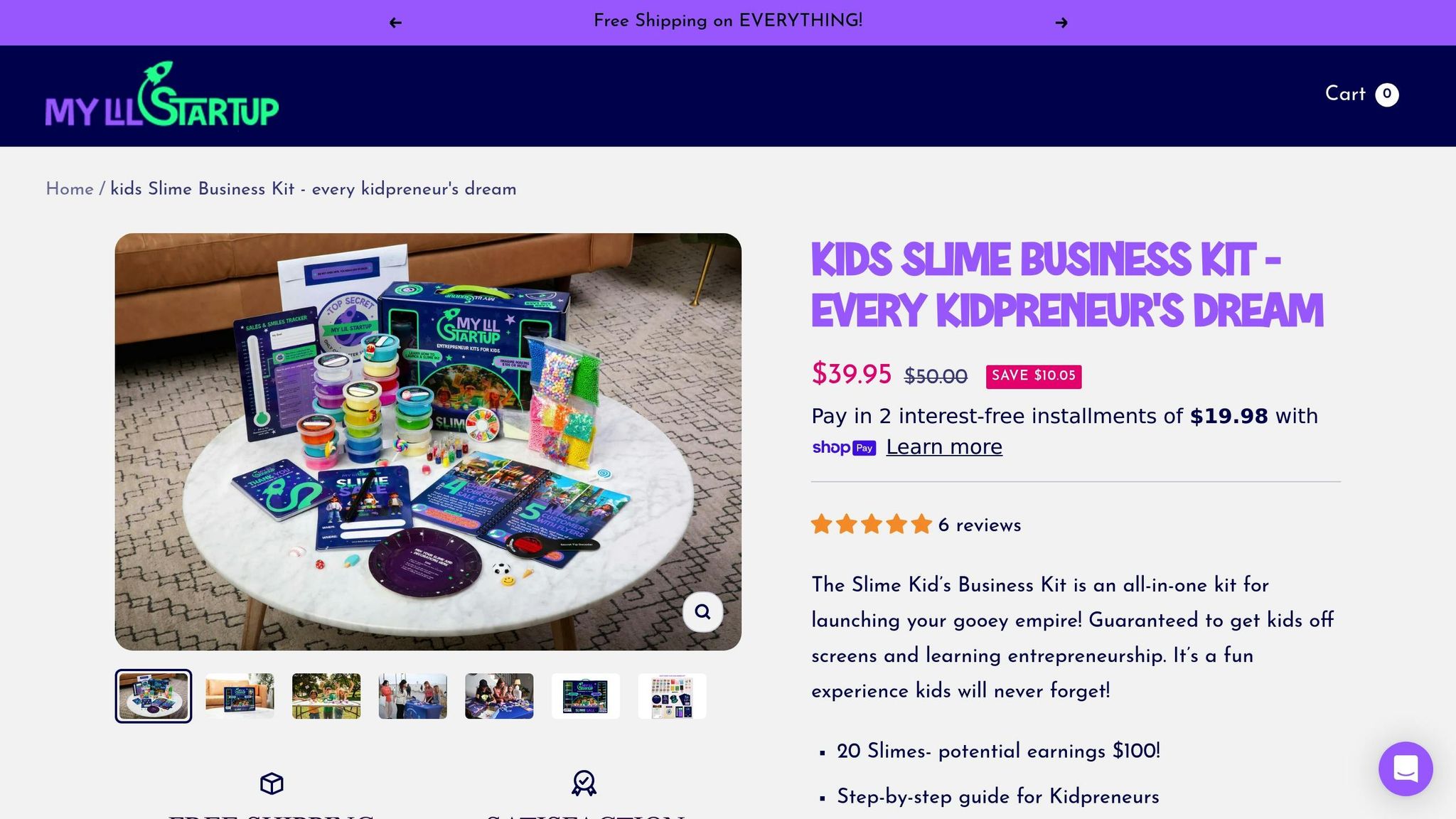Teaching kids about customer needs helps them create products that people want, boosting their confidence and business skills. Here's what you need to know:
- Customer Needs: These are the reasons people buy products, like features, price, or service quality. For example, slime buyers might value stretchiness or unique colors.
- Why It Matters: Understanding customers helps kids avoid wasting time on products that won't sell, leading to better sales and loyal customers.
- Finding Customers: Kids should focus on a specific audience, like classmates or parents, and tailor their products to their preferences.
- Using Feedback: Feedback helps kids improve their offerings and build stronger customer relationships.
- Solving Problems: Businesses succeed by solving customer problems, like creating mess-free slime or offering stress-relief toys.
Tools for Kids:
- Sales Trackers: Record sales to find trends in popular products.
- Thank-You Cards: Show appreciation and encourage feedback.
- Testing Ideas: Start with small batches to try new features.
The Slime Business Kit ($39.95) provides materials, tools, and guides to help kids learn these skills through hands-on experience. It includes supplies for making slime, sales trackers, and thank-you cards to teach business basics while having fun.
Customer Needs Explained - GCSE Business Revision
Basic Customer Needs Concepts
Grasping what customers need is at the heart of any thriving business - whether you're selling slime or handmade crafts. For young entrepreneurs, understanding these basics is a must. Here's a breakdown of the core ideas every budding business owner should know, along with tips on identifying the people who will benefit most from their product.
Finding Your Target Customer
A target customer is the specific group of people most likely to want and benefit from a product or service. Instead of trying to appeal to everyone, young entrepreneurs should focus their energy on those who truly need their product.
"Your target audience is the group of people most likely to want to buy your goods or services. As a business owner, if you can't define your target audience, you're setting yourself up for failure." - Adobe Express
Creating a clear picture of the ideal customer is vital. For instance, a child selling handmade bracelets might aim for kids and teens who love one-of-a-kind accessories. A slime business could target classmates who enjoy sensory toys, younger kids drawn to bright textures, or even parents searching for stress-relief items.
The idea is to ask: Who needs this product, and who is ready to pay for it? For example, a slime seller could consider whether their customers are elementary school kids looking for fun, middle schoolers needing stress relief, or parents shopping for birthday gifts.
"Understanding who your product or service is for is crucial. Create a simple profile of your ideal customer. Consider factors like age, interests, and why they would love your product." - Adam Toren, Co-founder of Kidpreneurs.org
When kids know exactly who their target customers are, they can focus their efforts more effectively. This clarity helps them make smarter choices about product features, pricing, and even how to market their business.
How Customer Feedback Helps
Customer feedback is like a compass, guiding young entrepreneurs toward what works and what needs tweaking. It’s a direct line to understanding customer preferences and improving products.
By gathering feedback, kids can learn what their customers love and what they’d like to see improved. A slime seller, for example, might discover that glittery slimes or certain scents are a big hit. This insight allows them to adjust their inventory to match what people actually want.
Feedback also helps spot issues that might otherwise go unnoticed. Maybe customers mention that slime containers are tricky to open or suggest adding more decoration options. These comments provide actionable ideas for improvement, making products better and customers happier.
Instead of guessing whether a new slime color will be popular, kids can simply ask their customers or test small batches. This approach saves time, money, and effort while boosting the odds of success.
Regular feedback also strengthens customer relationships. When people see that their input matters and leads to real changes, they feel more connected to the business. That connection often turns them into loyal, repeat customers. Armed with this valuable information, young entrepreneurs can tackle challenges head-on and grow their ventures.
Solving Customer Problems
At its core, every successful business solves a problem for its customers, and kid-run businesses are no exception. The trick is identifying what customers need and finding ways to meet those needs with products or services.
For example, a child offering pet-sitting services solves the problem of busy families needing reliable care for their pets. A young baker selling homemade cookies provides a solution for people craving fresh, tasty treats without the hassle of baking.
A slime business might address needs like stress relief, creative play, or sensory stimulation. Parents buying slime could be looking for screen-free activities or calming toys for their kids. By understanding these deeper needs, young entrepreneurs can create products that truly connect with their customers.
Listening carefully to customers is key. If parents mention that slime is too messy for car rides, a smart entrepreneur might develop a less sticky version or improve the packaging. If customers ask for slime that doesn’t leave residue on hands, that’s an opportunity to create a new variation.
"If you try to sell to everyone, you'll find it very difficult to focus your marketing efforts." - business.gov.au
Solving problems isn’t just about the product - it’s about the entire customer experience. This could mean offering friendly service, fast delivery, fair pricing, or helpful tips. For instance, a young slime seller might include care instructions with each purchase or offer replacements if a product doesn’t meet expectations.
When kids focus on solving real problems for their customers, they add value that goes beyond a single sale. They build trust, encourage repeat business, and often uncover new opportunities to grow. These skills lay the groundwork for deeper customer connections and long-term success.
Simple Ways to Connect with Customers
Building strong connections with customers starts with genuine conversations and truly listening to what they have to say.
How to Listen to Customers
Active listening is all about focusing on what your customers are sharing. For instance, if someone mentions their slime dried out too fast or they’d prefer a different color, take note of those details. Asking follow-up questions like, "What do you mean by too sticky?" or "What color would you love to see?" can help you dig deeper and better understand their experience.
Show that you’re fully engaged by maintaining eye contact, nodding, and avoiding distractions. These small actions encourage customers to open up. Taking notes - whether during the conversation or right after - can also be incredibly helpful. For example, jotting down something like "Emma prefers glittery slime" or "Mom is looking for mess-free options" ensures you don’t forget valuable feedback.
Once you’ve mastered listening, asking thoughtful questions can take your understanding of customer preferences to the next level.
Asking Questions About What Customers Like
Asking the right questions can reveal insights you might not uncover otherwise. Open-ended questions, in particular, encourage detailed responses that go beyond a simple "yes" or "no". For example, instead of asking, "Do you like this slime?" try something like, "What do you enjoy most about playing with slime?"
Here are some great conversation starters for young entrepreneurs:
- What’s your favorite color? Do you prefer sparkly textures or smooth ones? What makes this toy fun for you?
- When do you usually play with slime? How could it be even better? If you could change one thing, what would it be?
- Have you ever had issues with slime before? What’s the most frustrating thing about messy toys? How do your parents feel about this?
Giving customers a chance to share their thoughts makes them feel valued and included, which helps build trust.
These kinds of questions can also lead to fresh ideas, like adding storage containers or offering DIY slime-making kits. By listening and engaging thoughtfully, you can uncover opportunities to improve and grow.
sbb-itb-a46f019
Tools for Collecting Customer Feedback
Understanding what your customers want is key to running a successful business. Using simple tools to gather feedback can make a big difference, especially for young entrepreneurs who are just starting out.
Using Sales Trackers and Thank-You Cards
Sales trackers are a great way to spot patterns in what customers are buying. By recording each sale - like "Emma bought blue glittery slime for $5 on Saturday" - you can start to see trends. For example, maybe sparkly slimes sell better on weekends, or younger kids prefer brighter colors while older ones go for darker shades.
The sales tracker included in My Lil Startup's Slime Business Kit makes this process easy. It allows you to log details like the date, customer name, product sold, and price. Over time, these records can show which products are your top sellers and which ones might need a little tweaking.
Thank-you cards do more than just show appreciation - they also encourage feedback. When you hand someone a thank-you card, they might say things like, "This slime lasted forever!" or "It would be cool if this came in purple." These off-the-cuff comments can give you valuable insights into what your customers love or what they wish you offered.
The thank-you cards in the kit also help build stronger customer relationships. When people feel appreciated, they’re more likely to come back or even recommend your business to friends. This not only boosts repeat sales but also gives you more chances to gather feedback.
By combining the insights from sales trackers and thank-you cards, you’ll have a clearer picture of what’s working and where you can improve.
Testing New Product Ideas
Customer feedback often sparks ideas for new products or tweaks to existing ones. The trick is to start small and test one change at a time. For instance, if several customers ask for glow-in-the-dark slime, you could experiment by adding glow powder to a few batches and see how they sell.
Compare the results directly. Make a small batch of your regular slime and another with the new feature, then track which one sells faster. This method helps you figure out if the suggestion actually leads to better sales.
Keep detailed notes during these experiments. Write down what you changed, how customers reacted, and whether sales improved. Not every idea will work out, and that’s okay. The goal is to understand what your customers truly want, not to guess.
Starting with small batches is also a smart way to test ideas without wasting resources. If something doesn’t work, you won’t have invested too much time or material into it.
Learning and Improving Over Time
The best young entrepreneurs treat customer feedback as an ongoing process. Every interaction with a customer is a chance to learn something new about their preferences.
With practice, you’ll start to notice patterns. For example, weekday buyers might prefer simpler slimes because they use them to unwind, while weekend shoppers might go for more decorative options meant for playtime. Recognizing these trends can help you tailor your products to different types of customers.
Even negative feedback is useful. If someone says your slime is too sticky or the container is hard to open, they’re pointing out areas you can improve. Fixing these issues can turn a one-time buyer into a loyal fan.
Review your sales and feedback regularly. Ask yourself: What’s selling well this week? Are there any recurring complaints? What new ideas should I try next? This kind of reflection helps you stay on top of your customers’ changing needs.
Keep in mind that what’s popular now might not be as successful in a few months. For instance, summer trends might differ from winter ones. Stay adaptable and keep listening to your customers - they’ll guide you in the right direction through their feedback and purchases.
How My Lil Startup Helps Kids Learn Customer Needs

My Lil Startup is all about giving kids a hands-on entrepreneurial education, teaching them to understand customer needs through real-world business experience. The centerpiece of this initiative? The Slime Business Kit, a fun and practical tool that equips young entrepreneurs with everything they need to dive into the world of business.
Learning with the Slime Business Kit

The Slime Business Kit is designed to help kids grasp customer preferences in a tangible way. For $39.95, the kit comes packed with enough materials to create 20 unique slimes. It includes a mix of exciting add-ins like rainbow glitter, charms, beads, and even glow-in-the-dark powder. This variety allows kids to experiment with different combinations and figure out what appeals most to their "customers."
The kit encourages kids to sell their creations locally, offering instant feedback on what works and what doesn’t. For example, they might notice that younger kids are drawn to bright, glittery slimes, while others prefer unique textures or specific add-ins. To guide them through the process, the kit includes the "Your Success Instruction Book", a step-by-step guide that walks them through everything from creating products to interacting with customers. With a Perfect 5 Stars rating, the kit has proven to be a hit, delivering valuable lessons in a fun and engaging way.
Building Connections with Flyers and Thank-You Cards
To teach the importance of customer relationships, the kit includes promotional flyers and thank-you cards. The flyers help kids attract attention by sharing details about their business, while the thank-you cards add a personal touch that leaves a lasting impression. These cards aren’t just about being polite - they also encourage customers to share feedback, giving kids insights into what’s working and what could be improved. It’s a simple but effective way to teach that building relationships is just as important as making a sale.
Tracking Customer Favorites
The kit also features a Sales Tips & Tracker, a tool designed to help kids keep tabs on their best-selling products. By tracking what customers buy most, kids learn how to use data to make smarter decisions instead of relying on guesswork. This skill is key to running any successful business.
Building Skills Through Understanding Customers
Grasping what customers truly need isn't just about running a business - it’s also a powerful way to develop essential life skills. When kids dive into entrepreneurship, they sharpen their ability to think critically, solve problems creatively, and adapt to unexpected challenges. Whether it’s figuring out how to handle a supply issue or tweaking a product to better suit customer preferences, these experiences teach them how to make thoughtful decisions and tackle problems head-on.
Why Understanding Customers Matters
Understanding customers goes beyond selling - it’s about improving communication and decision-making. Kids learn the importance of asking meaningful questions, listening carefully, and using that information to make smarter choices. By keeping track of sales and paying attention to customer feedback, they build their analytical skills and learn how to turn setbacks into opportunities for growth.
For example, when a product doesn’t sell as planned, it becomes a chance to ask, “What can I do differently?” Adjusting and trying again teaches resilience, a skill that proves valuable in both business and everyday situations. Over time, this persistence and adaptability help kids approach challenges with confidence and determination.
Supporting Kids in Developing Business Skills
Parents play a key role in helping kids build these skills by encouraging them to learn from real-world experiences. Tools like the My Lil Startup Slime Business Kit, priced at $39.95, provide everything kids need to start their own business. Along the way, they practice money management, customer interaction, and problem-solving - all under the guidance of a supportive adult.
Ultimately, understanding customer needs isn’t just a business strategy - it’s a life lesson. These early entrepreneurial experiences show kids how valuable it is to understand others, whether they’re working on school projects, forming friendships, or preparing for future careers. The skills they develop now will serve them well in every stage of life.
FAQs
How can kids identify and connect with the right customers for their products?
To connect with the right audience, young entrepreneurs need to start by understanding what their customers genuinely want. This involves considering who would enjoy their product the most and identifying the features or benefits that would grab their attention. For instance, if you're selling slime, think about the colors, textures, or decorations that kids might find irresistible.
If you're using My Lil Startup's Slime Business Kit, make the most of the included tools - like marketing flyers and the sales tracker. These can help you gather insights about your customers' preferences. By paying attention to feedback and noticing which items sell best, you can tweak your approach and create products that are even more appealing to your audience.
How can kids collect and use customer feedback to improve their business?
Kids can begin by seeking honest opinions from friends, family, or classmates about their products or services. This kind of feedback can give them a better sense of what’s working and what might need improvement. They could also try creating simple surveys or casually asking for suggestions during conversations with customers.
Another great way to gather insights is by paying attention to comments or questions on social media and keeping a record of customer preferences. By actively listening and making meaningful adjustments based on what they learn, kids can refine their offerings, strengthen their connections with customers, and gain confidence in their journey as young entrepreneurs.
How does the Slime Business Kit teach kids to understand customer needs while building important business skills?
The Slime Business Kit offers kids an exciting, hands-on opportunity to learn how to identify and meet customer needs. By making and selling their own slime creations, they get to practice key skills like managing a budget, promoting products, and interacting with customers.
This immersive activity not only sparks creativity and encourages problem-solving but also boosts confidence and introduces kids to the basics of entrepreneurship. On top of that, the slime-making process helps improve fine motor skills and enhances sensory awareness, making it a fun and educational experience rolled into one.




